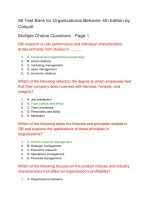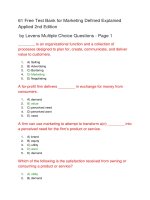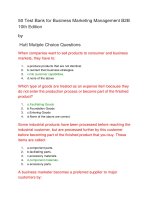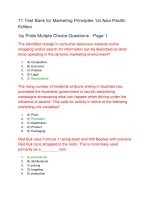Test bank canadian income taxation 2017 2018 20th edition william buckwold
Bạn đang xem bản rút gọn của tài liệu. Xem và tải ngay bản đầy đủ của tài liệu tại đây (160.45 KB, 5 trang )
Test Bank Canadian Income Taxation 2017 2018 20th Edition William Buckwol
Full
file at />Exam
Name___________________________________
MULTIPLE CHOICE. Choose the one alternative that best completes the statement or answers the question.
1) The CEO at Big Company Corporation has decided to sell a piece of capital equipment
1)
after the company's year-end in order to avoid paying capital gains tax this year. Which
tax planning method will the CEO be using?
A) Shifting income from one time period to another.
B) Converting the nature of income from one type to another.
C) Transferring income to another entity.
D) This is a form of tax evasion and is not allowed.
Answer: A
2)
Which of the following scenarios illustrates a potential tax avoidance scheme?
A) A shareholder owns two corporations and undertakes legal steps in order to permit
loss utilization between the two companies.
B) Dividends received from shares transferred from a wife to her husband are taxed in
the hands of the wife.
C) A man transfers property to his child at a value less than fair market value.
D) Property transferred between arm's-length parties is valued at fair market value.
2)
Answer: C
3) The controller of Little Company Ltd. has decided to sell a piece of capital equipment
3)
after the company's year-end in order to avoid paying tax on capital gains this year. The
controller is engaging in
A) tax planning.
B) tax avoidance.
C) tax evasion.
D) GAAR.
Answer: A
4)
Certain skills are necessary for successful tax planning. One of these skills is applying
the time value of money. Which of the following is FALSE regarding this skill?
A) If a taxpayer invests $1,000 for one year at a rate of return of 14% and is subject to
a 45% tax rate, the after-tax value of the investment will be $1,077.
B) If a taxpayer invests $1,000 at 8% and subsequently earns $48 in after-tax income
on the investment at the end of the first year, the taxpayer's tax rate is 40%.
C) If a taxpayer earns an annual return of 12% and is subject to a 40% tax rate, the
annual after-tax return is 4.8%.
D) Applying the time value of money is a tool used for wealth accumulation.
Answer: C
1
Full file at />
4)
Test Bank Canadian Income Taxation 2017 2018 20th Edition William Buckwol
Full file at />5)
Which of the following statements regarding GAAR is true?
A) The purpose of GAAR is to catch tax evaders.
B) Individuals who organize their affairs in order to pay as little tax as possible will
automatically be subject to GAAR.
C) The Canada Revenue Agency states that "A transaction will not be an avoidance
transaction if the taxpayer establishes that it is undertaken primarily for bona fide
business, investment or family purposes."
D) When an avoidance transaction takes place, the anti-avoidance rule is automatically
applied in all circumstances.
5)
Answer: C
ESSAY. Write your answer in the space provided or on a separate sheet of paper.
6) Steven James earned $150,000 this year in profits from his proprietorship, which placed him in a 45% tax
bracket. The rate of tax for Canadian-controlled private corporations in his province is 15% on the first
$500,000 of income. Personal tax rates (federal plus provincial) in James' province are:
On the first $46,000
On the next $46,000
On the next $50,000
On the next $61,000
On income over $203,000
24%
32%
40%
45%
50%
(All rates are assumed for this question.)
Steven withdraws $3,000 per month for his personal living expenses. All remaining profits are used to pay
taxes and to expand the business. Steven expects the same business after-tax profits next year.
Steven is considering incorporating his business next year. If he incorporates, he will pay himself a gross
salary of $48,000.
Required:
A. Determine the increase in Steven's cash flow if he incorporates his company? Show all calculations.
B. Name the type of tax planning that Steve would be engaging in if he incorporated his company.
Answer: A) Excess cash as a proprietorship:
Pre-tax Profits
$150,000
Tax:
24% 46,000
$11,040
32% 46,000
14,720
40% 50,000
20,000
45% 8,000
3,600
(49,360)
(Assume federal plus provincial rates)
After-tax profits
$100,640
Living expenses withdrawn
(36,000)
2
Full file at />
Test Bank Canadian Income Taxation 2017 2018 20th Edition William Buckwol
Full file at />Answer: Living expenses withdrawn
Available for expansion
(36,000)
$64,640
Excess cash as a corporation:
Profits before salary
Salary
Corporate pre-tax profits
Tax: 15% x 102,000
After-tax profits (Available for
expansion)
Excess cash available for expansion
($86,700 - $64,640)
$150,000
(48,000)
102,000
(15,300)
$86,700
$22,060
C) Transferring income from one entity to another (individual to corporation)
7) Part A: List the three key factors of cash flow.
Part B: List the six skills required for tax planning as suggested in the textbook.
Answer: Part A:
Three key factors of cash flow
1. Amount of money coming in
2. Amount of money going out
3. Timing
Part B:
Six skills required for tax planning
1. Anticipation
2. Flexibility
3. Speculation
4. Applying the 8th Wonder of the World
5. Perspective
6. Global approach
3
Full file at />
Test Bank Canadian Income Taxation 2017 2018 20th Edition William Buckwol
Full file at />8)
Andrew has $10,000 to invest. He wants to put his money in a one-year investment earning an annual interest
rate of 12%. Andrew is in a 42% tax bracket.
Required:
a) Calculate the total value of Andrew's investment, after-tax, at the end of the year.
b) Calculate the amount of taxes Andrew will have to pay on his investment.
Answer:
a) ($10,000 × 1.12) × (1 - .42) = $10,696
b) $10,000 × .12 × .42 = $504
9) Match each of the following terms with the most accurate example. Use each example only once.
TERMS:
Tax evasion
Tax planning
Tax avoidance
EXAMPLES:
A. An individual is seeking a beneficial outcome, and therefore, applies an application that is not specifically
prohibited by law.
B. A business is seeking a beneficial outcome, and therefore, does not report a portion of revenue earned
during the year.
C. Two unrelated companies take steps to become related in order to shift income from the profitable business
to the company with losses.
Answer: An individual is seeking a beneficial outcome, and therefore, applies an application that is not
specifically prohibited by law. Tax planning
A business is seeking a beneficial outcome, and therefore, does not report a portion of revenue earned
during the year. Tax evasion
Two unrelated companies take steps to become related in order to shift income from the profitable
business to the company with losses. Tax avoidance
4
Full file at />
Test Bank Canadian Income Taxation 2017 2018 20th Edition William Buckwol
Full file at />10) For each of the examples listed below, state which of the following three categories of tax planning has been
applied:
Shifting income from one time period to another
Shifting income from one entity to another
Shifting income from one type of income to another.
A. Jack has run a successful proprietorship for the past four years, and has now decided to incorporate his
company.
B. Karen has decided not to pay herself a dividend from her corporation, (of which she is the sole shareholder),
but has chosen to sell a portion of her shares to an associate instead.
C. XYZ Corporation has chosen to delay the recognition of a discretionary reserve until the following year.
Answer: A. Shifting income from one entity to another
B. Shifting income from one type of income to another
C. Shifting income from one time period to another
5
Full file at />









